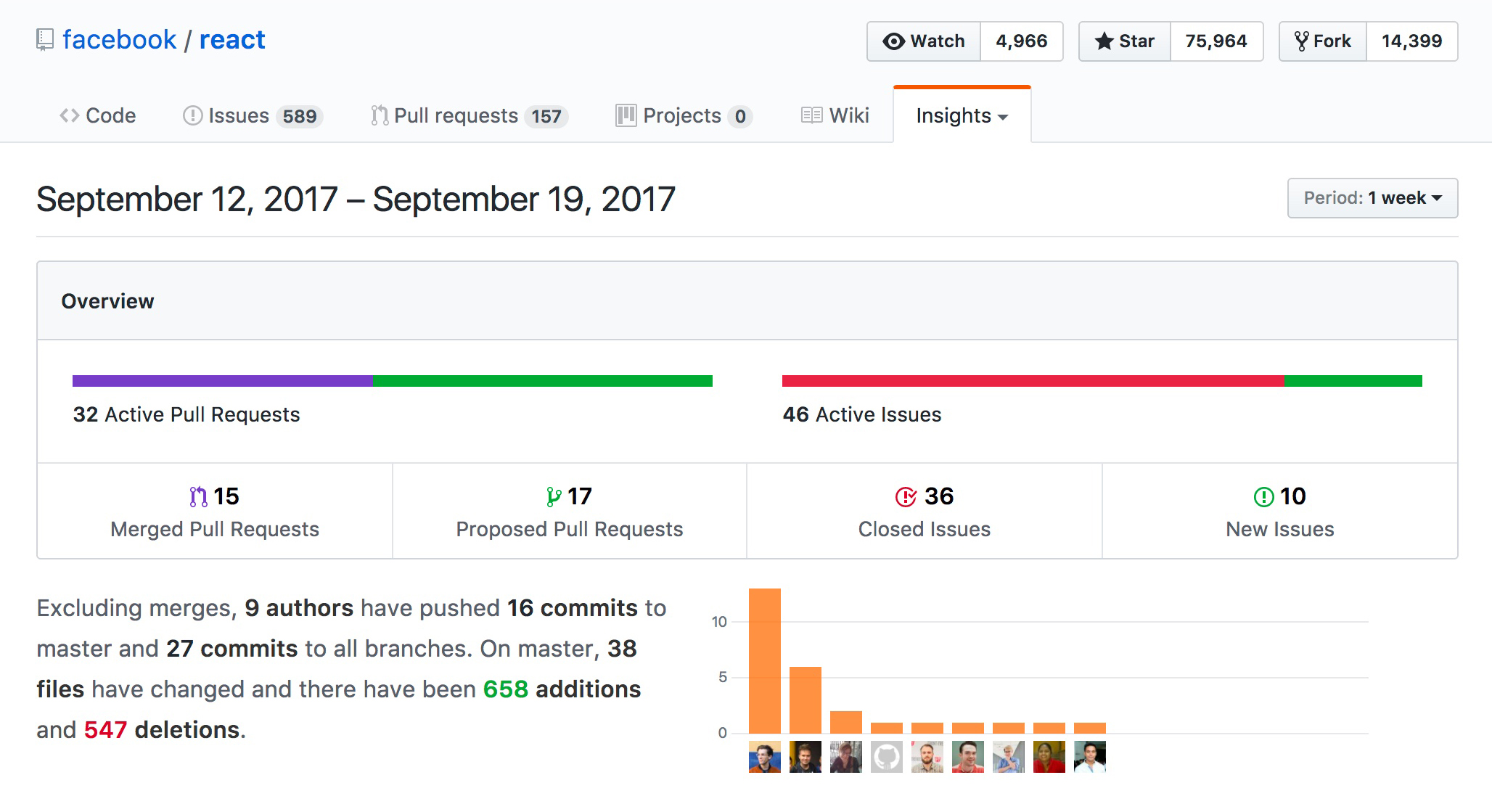Reality check for designer
The digital industry is moving in on a fast track. Let’s look at some simple numbers Looking at one of the most popular solutions “facebook react” for example, up to this date, there are 50+ branches. There are 15 merged pull request, 17 proposed pull request. These seem are the numbers we can make sense of, but if you compared this to tradition industry delivery, then no company will change a ready-to-ship chair 15 times within a week.
 All these numbers are just reflection of the fast pacing and agile sprints. There is no doubt that the methodology is shaping the way we work, and influencing how the end products look and feel like. So how should designer adapt in this fast-paced flow, more importantly, how can designer contribute and create value to the greater whole?
All these numbers are just reflection of the fast pacing and agile sprints. There is no doubt that the methodology is shaping the way we work, and influencing how the end products look and feel like. So how should designer adapt in this fast-paced flow, more importantly, how can designer contribute and create value to the greater whole?
How designers used to do it? Successful case from the past
Each revolution comes with a group of pioneers, they explore the border of uncharted territory. In order to understand where designer and business are moving forward, we should first look at the past.
Charles Eames has no-doubt given the modern design history a rich legacy, from the distinguish Eames Lounge Chair to the Powers of Ten), he shows his tireless pursue on creative production, and always lives by his motto
We wanted to make the best for the most for the least
Charles Eames
So how did he rise and achieve all this? Of course not by himself, we also have to understand he has lived in a very different time. During 2 of the greatest war; The Great Depression, these all helped him to accumulate a steel-like mindset and rich design resources, Charles Eames himself has great raw talent and fluid intelligence, but it is the crystallized knowledge, the learning from over 2 decades that differentiates him from other great designers. After The Great Depression, he gained access to the “state of the art” machinery “Kazam!” to experiment on bending plywood, and this technique ultimately becomes the cornerstone for his signature organic furniture design. There are 2 important facts contribute to his creative work:
- Accessibility: Access to technology and resources.
- Sustainability: A long period of working on the specific subject and feeding accumulated knowledge back to production.
These 2 facts provide him a unique zone to connect/experiment his creativity and the mass production technology.

Unexpected challenges for digital designer
So in a faster and agiler page, will the above 2 major factors still impact how a designer can create values for their team? We definitely are getting better and better on accessing the technologies and resources, but it comes with unexpected challenges.
Unexpected challenges 1: Don’t let technology shape your creativity
We are living in an open-source world, everything seems just a click away. It is easy to find your digital product looks and feels similar to your competitors. This happens not because lacking accessing technology, but the convenience of accessing technology. It is so easy for everyone to access technology today, and unfortunately, it is even easier to allow technology dominate and shape our creativity. This easy access could heavily influence the creative value, which designer used to contribute to a long-term based project. Each time when we switch a design tool, frameworks or method, we should all take a step back and ask ourselves, what is the trade-off and what is the end-goal? Are you sacrificing your design creativity for productivities? So if you find a visual style is easier to make and easier to maintain in a certain program, always experiment alternatives before you commit 100 percent to it, because you are exposing yourself not exploring the unknown, putting technology ahead of human basis, and not gaining any learnings from the designing process.
Unexpected challenges 2: Fast is good, ONLY when you arrive the right destination
We try to re-create the “accumulated learning feedback loop” by introducing the “Design sprint” and “agile development” to our creative process. But the high-speed development always tries to yield the max result in each time-limited sprint, I am not against this minimal-effort/high-impact approach, but I believe that we should always orient ourselves to the end goal before kick-starting each sprint. Because otherwise this approach can sometimes lead to deadly corner-cutting, and ultimately derail you and your product during the process.
For instance, how many times we throw the “let’s make a XXX MVP“ card on the table. There is nothing wrong with using XXX or the word “MVP”, but as a digital designer, we have to truly evaluate the important point here is not to make an isolated solution. As a digital designer, the value you provided shouldn’t end on a specific solution, but the value should be embodied the impact of the solution, can and should be re-visit, reuse throughout the whole process, therefore sustain the creative value from concept to end-product. So instead of creating another website solution, thinking about creating a dynamic storyboard, which allows all team members adding their thoughts throughout the project; or creating an inspiring user-journey video, which can inspire team member or clients to discover and explore new design challenges. Be careful not trap your creativities in an unsustainable/encapsulated product. A design process can be time-consuming, but it provides clarity and confidence for the team to navigate to the right destination.
So, what are the most important attributes can help the digital designer overcome the unexpected challenges in the fast pacing creative process?
Design in its nature is about exploring different possible solutions to a specific problem or challenges. A lot of people misunderstand that design is result-driven because, at the end of the line, a designer should deliver a finished design answer. But I always like to think that designer should emphasize the word exploring, the possible solutions are just a by-product/foot-print of exploring different scenarios. This leads me to 2 important attributes for the creating value in the sprint process and still maintain the fast development speed and momentum.
- Structured design experiment and exploration
- Clear end goal definition
Structured design experiment and exploration
It provides a better vision on how your team navigate through multiple designs or development iterations, and where your team should focus on at current and future
So what structured design document is like? Unfortunately, there is no one-size-fits-all solution here because even in the world of Invision and Zeplin, some project still requires different method(fx. if you are doing animations.). But as mentioned above, Invision and Zeplin is a good start point, especially Invision seems become more integrated with the project management tools.
A well-structured design experiment doesn’t necessarily mean deep and complex structures, rather it often follows the ‘SSOT’ or Single Source of Truth. So When you are conducting a design experimenting(fx. color usage), always make sure it is not a duplicated experiment. Because this duplicated experiment if not always but often leads to a duplicated result, and it often can put too many variables on your end result and can cloud your design judgment.
A well-structured design experiment also should cover all usage/use-case of your design element. So if you wanted to decide how one particular color should be included in your secondary or tertiary palette, not only you should look at relations between the colors, but you should also be able to list if not all but most of the usage of this particular color. Because it provides you visual evidence in order to make a better judgment and design decision. Of course your design should be full of surprise to your users, but it shouldn’t throw too many surprise to yourself.
Clear end goal definition
Be visible. The design builds on logic, a good visual language should be able to speak for itself.
As a designer, one of the most important assets you bring to the table is the ability to simplify complex and abstract logic to comprehensible visual language. It is not difficult for different team members to understand a brief or a business logic, but different cultures, education background, and earlier professional experience can lead to different interpretations. It is important for the team to embrace this diversity because it differentiate us from the machine, it makes your end product human. But from time to time, we really need to align these differences, FAST. It is easy to lose yourself from a 50+ page of requirement and details. So it is important for visual designers to take lead and transform the essence of logic to understandable and inspiring universal visual languages.
Inaction breeds doubt and fear
Dale Carnegie
Don’t be afraid of perfection, open up your sketchbook, making the first strike is always tough, but if you wait then nothing will happen. Taking criticism, and build on top of it, and then repeat. Because by excising your visual design language you are providing your team valueable assets of communication and understanding.
Resolve compromise by providing visual assistance to your team.
Another additional value you can add to your team as a designer is to identify and resolve compromise before your team is stuck with them. We all hate compromises, and they might be the biggest foe to your development progression. But it is too often we tackle compromise too late in the process, often at a stage of lacking time and resources. As a designer, it is trained reflection to avoid compromises, but it is more important to address them. Because by addressing compromises by visual examples before ‘GO’, we can look at challenges in different angels, and probably leads to more suitable solutions.
The end and short reflections
This is just my individual learnings from my earlier work, it might not suit every project, but I hope it will bring some light to my digital approach, and maybe someone from the world will find it interesting to read.
Every single part of the development project brings different values. Some digital projects might not even need heavy influence from the design perspective. Some digital projects might face critical design issues without realizing it. It is definitely not easy to navigate between the fast digital current at the moment as a digital designer, speed and creativity rarely come hand in hand. But looking from the past, we are not going to slow down this development for any excuses, therefore it is more important for the digital designers to adapt to the norm and accelerate the digital development. So we can keep creating sustainable design solutions and simplifying complex problems.
 All these numbers are just reflection of the fast pacing and agile sprints. There is no doubt that the methodology is shaping the way we work, and influencing how the end products look and feel like. So how should designer adapt in this fast-paced flow, more importantly, how can designer contribute and create value to the greater whole?
All these numbers are just reflection of the fast pacing and agile sprints. There is no doubt that the methodology is shaping the way we work, and influencing how the end products look and feel like. So how should designer adapt in this fast-paced flow, more importantly, how can designer contribute and create value to the greater whole?
